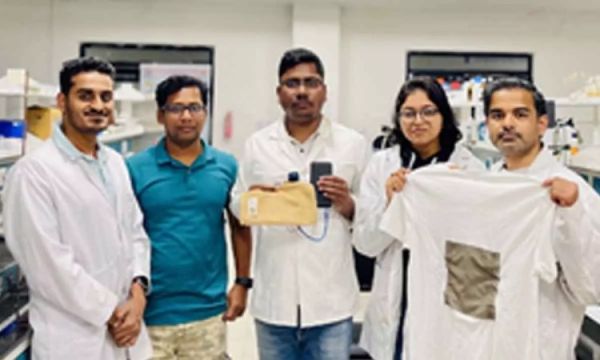Scientists at the Indian Institute of Technology (IIT) Guwahati created a conductive, water-repellent fabric that generates heat from energy and sunshine.

The invention, which is intended to keep users warm in cold climates, tackles the major health hazards associated with extended exposure to very low temperatures, such as hemoconcentration-based arterial blood clotting, respiratory problems, and compromised immunity.
Although conductive fabrics provide a flexible and lightweight substitute, current models are susceptible to water exposure, have poor durability, and use a lot of electricity.
To make cotton fabric conductive, the new fabric sprayed clean, ultra-thin silver nanowires onto it. Being 100,000 times thinner than human hair, these nanowires enable electricity to pass through the fabric, assisting in the generation of heat while maintaining the fabric’s softness and flexibility.
Our fabric is flexible, breathable, self-cleaning, and readily expandable. It is helpful in a variety of applications that call for regulated heating due to its robustness and long-lasting performance,” said Prof. Uttam Manna of the Department of Chemistry at IIT Guwahati.
Silver nanowires were used by the researchers because of their remarkable electrical conductivity and capacity to generate heat from both electricity and sunlight. Silver’s low electrical resistance removes the possibility of electrocution and permits electrothermal conversion at low applied voltage.
The researchers coated the silver nanowires with a water-repellent substance to shield them from oxidation, water, and stains, even though they may tarnish over time and impair performance.
Because of the coating’s nanoscale rough surface texture—which was inspired by lotus leaves—water rolls off rather than soaks in. Even in moist situations, this keeps the material dry, guaranteeing long-lasting conductivity and efficient heating.
In the report published in the journal Nano-Micro-Small, the researchers said that the water-repellent coating is dependable for outdoor and daily usage since it also guards against damage from perspiration, rain, or unintentional spills.
Additionally, the textile can sustain a chosen temperature between 40 and 60 degrees Celsius for more than ten hours by converting power into heat using solar energy or a tiny rechargeable battery.
The textile’s ability to deliver long-lasting warmth for those working in cold conditions and arthritis sufferers in need of localized heat treatment was shown by the researchers’ testing of it in wearable knee and elbow bands.
Contact to : xlf550402@gmail.com
Copyright © boyuanhulian 2020 - 2023. All Right Reserved.